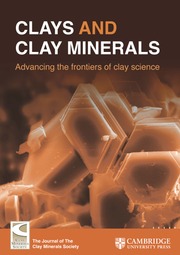Article contents
Surface Area and Porosity of Nanotubes Obtained from Kaolin Minerals of Different Structural Order
Published online by Cambridge University Press: 01 January 2024
Abstract
Mesoporous materials with pore diameters in the range 2–50 nm forming tubular or fibrous structures are of great interest due to their unique properties. Because they are commonly used as sorbents and catalyst carriers, knowledge of their surface area and porosity is critical. A modified intercalation/deintercalation method was used to increase the efficiency of nanotube formation from kaolin-group minerals which differ in terms of their degree of structural order. Unlike previous experiments, in the procedure adopted in the present study, methanol was used instead of 1,3-butanediol for grafting reactions and octadecylamine intercalation was also performed. The samples were examined using X-ray diffraction (XRD), Fourier-transform infrared spectroscopy (FTIR), differential scanning calorimetry (DSC), and transmission electron microscopy (TEM). The specific surface area and porosity of previously described and newly formed materials were investigated by N2 adsorption/desorption. Compared to results described earlier, the percent yield of nanotubes obtained in the present study was significantly greater only in the case of ‘Maria III’ kaolinite, which has high structural order. This increase was obtained mainly by the grafting reaction with methanol. Highly ordered stacking of kaolinite-methanol intercalates was noticed and, thus, the amine intercalation was more efficient. In particular, the use of long-chain octadecylamine significantly increased the nanotube yield. The grafting reaction with methanol procedure yielded fewer nanotubes, however, when applied to poorly ordered samples (‘Jaroszów’ kaolinite and ‘Dunino’ halloysite). In the case of the ‘Maria III’ kaolinite, the diameter of the rolled layers observed by TEM was ~30 nm and corresponded to average diameters of newly formed pores (DmN) determined using N2 adsorption/desorption, confirming that nanotubes contributed to an increase in surface area and total pore volume. In the case of ‘Jaroszów’ kaolinite and ‘Dunino’ halloysite mainly macropores (DmN > 100 nm) and mesopores (20 nm > DmN > 40 nm) were formed. The pores were attributed to interparticle and interaggregate spaces in the stacks of platy particles and to the small relative number of nanotubes.
Information
- Type
- Article
- Information
- Copyright
- Copyright © The Clay Minerals Society 2011
References
- 40
- Cited by

